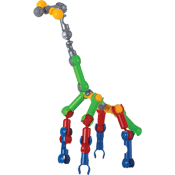This week Joanne came up with fabulous ideas about
LOGI SHAPES
DESCRIPTION: The child is expected to follow the logi shape cards and position the coloured logi shapes to make the same design as that represented on the card (either directly on top of the card or on the table).
SKILLS that can potentially be developed :
• Fine motor skills (hand grasps)
• Position-In-Space
• Visual-spatial skills
• Visual form constancy (A shape is the same shape even if it is a different colour, size or orientation)
• Visual memory
• Visual-motor integration
• Tactile discrimination
• Planning/organisational skills
• Number / colour / shape concept
• Sequencing skills
• Creativity
SOME ALTERNATIVE IDEAS
• With younger children: The shapes can be used to develop colour concept by grouping different shapes of the same colour. Alternatively encourage your child to make groups of the same shape. Of course, they can also be counted which develops number concept.
• Younger children also love to press the shapes into play dough to make different shapes (good for developing the muscles of the hand and strengthening little wrists, especially if you get them to do this on a vertical/tilted surface). Using the shapes to cut play dough encourages the development of the finer hand grasps.
• If you place a piece of paper over a shape, you can do great crayon rubbings of the shapes.
• Roll the colour and/or shape dice (part of the package) and let your child find a shape of the same colour or shape as seen on the dice. Start with only the shape or only the colour dice and upgrade to using both dice at the same time
• You can also play a game whereby you and your child each roll the colour and shape dice and see who can complete the design on the logi shapes card first.
• Instead of copying the logi shape patterns on a horizontal surface, get your child to roll little balls of prestik (also great for developing finger movements for handwriting), and then sticking the logi shapes on a window/wall/sliding door to make the design represented on the card. This also develops wrist stability (important for hand skills). (I LOVE this idea - Joyful Mama.)
• Creativity can also be tapped into by encouraging your child to create his/her own designs with the shapes.
• Sequencing skills (important for numeracy and literacy) can be developed through creating a specific sequence of coloured shapes which your child needs to replicate or extend. I use the shapes to stimulate visual memory by making a sequence of shapes and then covering it and asking the child to copy the sequence either with the logi shapes themselves or by drawing the shapes.
• To develop visual-motor integration, get your child to draw the design on the logi shape card after building it with the shapes.
• Hide a few of the shapes in a sock or bag and get your child to try and guess what shape they are feeling (tactile discrimination)
GENERAL COMMENTS
The materials are very durable
Additional shapes and cards can be bought separately.
Logi shapes are a great investment as they can be used to develop a multitude of skills in a variety of different ways (the above list of alternative ideas is by no means exhaustive!)













































